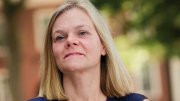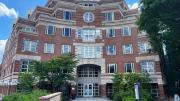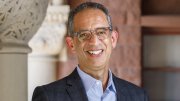The acronymically burdened final report of the GAGE working group (GSAS Admissions and Graduate Education), released early in the fall semester, is in fact a vigorous and urgent overview of the Faculty of Arts and Sciences’ intellectually central Ph.D. programs, which enroll about 2,500 students. (FAS’s Graduate School of Arts and Sciences, GSAS, also educates a much smaller cohort of master’s degree candidates and collaborates with the professional schools on offerings for another 2,000 or so Ph.D. prospects.) The working group stemmed from FAS’s 2020-2021 Faculty Study Group (see harvardmag.com/fas-plans-21), which urged a “student-centered approach to graduate education,” which seeds the scholarship of the future. GAGE, organized in early 2022 and led by GSAS dean Emma Dench, was charged with examining “advising, teaching, employment outcomes, institutional finances, and equity, diversity, inclusion, and belonging to develop actionable steps in how admissions slots are allocated and to outline what the Ph.D. means in the twenty-first century.”
As a practical matter, the report’s many findings and recommendations, the first to emerge from FAS strategic self-examination, reach two overarching conclusions, focused on advising (at the core of students’ training) and the resources that Harvard dedicates to doctoral education. In the blunt language of the executive summary:
The threat to Harvard’s preeminence in education is real and…requires urgent action. Taking measures to ensure that students receive the guidance they need to successfully complete their academic programs is one important step….The other equally important step is money: the best education and reputation in the world is no longer enough to attract the most promising students. Harvard must increase its financial support or risk being left behind.
To begin at the end, the report documents that many doctoral students no longer end up in academic careers. Among Ph.D.s graduating between November 2020 and May 2023, more than 80 percent of those in arts and humanities and qualitative social sciences sought careers in academia or higher education (but just about two-thirds of quantitative social sciences graduates, and less than half of those in natural sciences, were so inclined). They may be disappointed.
The GAGE report summarizes initial and subsequent employment for the classes of 2007-2009 and 2012-2014, 10 and 5 years post-Harvard. Overall, it concludes, “For those whose initial employment is in the academic sector, the…percentage entering tenure-track or other long-term faculty positions immediately is decreasing while the…number entering postdoctoral positions is increasing.” Notably, the postdoc—long the expected path for science and engineering graduates—accounted for 24 percent of 2012-2014 arts and humanities Ph.D.s with initial academic placements, 37 percent of quantitative (economics and government) social scientists, and 46 percent of qualitative social scientists: up substantially from the share for each group from the 2007-2009 cohort. And in each case, the share in tenured or tenure-track faculty positions five years after graduation was down (in the case of arts and humanities professionals, by 15 percentage points) compared to similar placements for the 2007-2009 graduates. Unsurprisingly, the proportion of scientists and engineers bound for industry remained fairly strong.
Although the survey data reveal that recent (2020-2023) graduates consider their Ph.D. training “very relevant” to their initial job search and outcome (more than 80 percent for all disciplines except the scientists, who scored in the high 70s), their changing career trajectories suggest the importance of appropriate mentoring and advising during their multiyear studies.
That subject is central to Dean Dench’s interests and to GAGE’s work. In an autumn conversation, she recalled her own Oxford advising as “not terrible, sort of traditional,” delivered by “kind and well-meaning people.” She began prompting discussion about Harvard advising from her appointment as interim dean in 2017, aiming to “help the faculty do the best possible job with our amazing graduate students.” As dean during the pandemic, her focus sharpened further, given students’ prolonged isolation. Although 84 to 94 percent of students characterized the effectiveness of their primary adviser as “excellent” or “very good,” when asked who among the faculty could improve, Dench did not hesitate to respond, “Honestly, all of us.”
Reflecting on her own experience as an adviser, she continued, “I’ve never been trained. It wasn’t a thing.” The report makes mention of “people who may intuitively understand how to mentor or who develop and follow their own robust processes of support.” One is reminded of attitudes toward teaching a few decades ago: that good work in the classroom was innate or intuitive, rather than something to be explicitly taught, evaluated, and enhanced.
That is no longer the case for pedagogy, and GAGE insists on similar commitments to excellence in advising. Accordingly, the recommendations have plenty to say about how to “codify what constitutes effective advising”—and perhaps, reading between the lines, what has been too often overlooked.
For example, all of a department’s advising should not fall to just a few professors, lest they become overburdened and unable to devote sufficient time to each student. Having more advisers also protects students from becoming too dependent on one mentor, who may go on leave, not have sufficient disciplinary breadth to develop a student’s interests, or simply not work out. Similarly, students need to be permitted and encouraged to develop advising networks. Junior faculty ought to be trained to “foster advising capability.” Ph.D. programs should outline expectations about the length of a course of study and timely progress toward the degree. Dissertation committees ought to meet with the student at least once annually. And so on.
GSAS, Dench said, is now assessing doctoral programs’ compliance with these minimum standards, or progress toward doing so. That auditing comes with a big stick: demonstrably effective advising will be a major factor in allotting admissions slots in the future. Nor is that an idle threat: during the pandemic, GSAS reined in admissions, in part so it could support students already enrolled whose research and progress to degree was necessarily interrupted. Although the FAS-based Ph.D. cohort has remained relatively level, at around 2,500 since academic year 2009 (the advent of the Great Recession), it did decline from a peak of 2,612 in 2021 to 2,451 in 2023. To faculty members whose research and intellectual engagement depend heavily on interacting with their graduate students, this is a serious matter. (And the pandemic-era changes mask a secular change in admissions: science enrollments have risen from 905 in 2009 to about 1,050 in recent years, in step with the growth in engineering and applied sciences at Harvard, but the arts and humanities and social sciences cohorts have each diminished by roughly 100 during those years.)
Admissions will also depend on “the scale and strength” of each academic program: the size and depth of applicant pools, the intellectual trajectory of each field, divisional deans’ assessments of potential faculty recruits in the context of the disciplines, and the FAS dean’s “institutional investment” in the graduate programs and the divisional deans’ “academic priorities.” Such matters largely lie outside GSAS’s direct purview but obviously affect students’ satisfaction with Harvard doctoral education and their future prospects.
Admissions allocations will depend as well on each program’s success in identifying and attracting “the most promising students to form a dynamic and diverse community” of visionary scholars, educators, and leaders of the future: that means recruiting beyond the familiar pipelines to graduate school.
Finally, the GAGE report puts the onus on programs to assure that students are properly prepared to embark on their chosen careers, and to move beyond admission traditions that serve interests other than the students’ own. For example, if the cohort of applicants in a given year appears less strong than usual, the number of offers of admission ought to be reduced. And it is no longer considered appropriate to admit students simply to cover College demand for teaching fellows.
Alongside changing career options and graduate students’ own expectations, the competitive environment is changing, too.
Alongside changing career options and graduate students’ own expectations, the competitive environment is changing, too. For all Harvard’s academic prowess, Dench acknowledges, “The competitiveness of our stipends became acutely on our radar,” especially during the last admissions cycle. Princeton’s 2022 decision to raise stipends 25 percent, to an average of $40,000 for the 10-month academic year, was a warning shot across the bow. The GAGE report called that increase “astounding,” and noted that the Tigers’ stipends exceeded Harvard funding by about $5,000 (12 percent) during this academic year. “We heard so much about programs losing some of their top choices to competitors,” Dench said of last year’s admissions. “We heard money [cited] much more than we ever had before.”
The difference in dollars is made all the more acute by Boston residential rents, which now rank among the highest nationwide. GSAS has about 417 beds for doctoral students across all programs: a tough comparison against peers that can offer much more housing, at costs they can control.
The GAGE report usefully explains graduate education financing. The critical figure is that science programs (typically funded through professors’ research grants) barely generate net unrestricted cash now, and doctoral education in the other disciplines consumes about $10 million in net unrestricted cash annually: costs that will increase to make stipends more competitive, to satisfy Graduate Student Union contracts, and to keep up with other expenses. FAS is solidly in the black (see page 22), but faces multiple demands on its resources, from faculty growth to undergraduate financial aid. And although the GSAS now bears the name of Kenneth C. Griffin ’89, his recent $300-million gift went to FAS as a whole, not to graduate education per se (see harvardmag.com/griffin-fas-23).
Dench summarized GAGE’s work by citing the faculty’s “energy around this project”: a focused approach to sustaining the excellence of doctoral education at Harvard. But that focus on matters internal is now wed to a large, external concern as well: “Acknowledging that graduate students fuel Harvard’s research engine, the University should prioritize investment in graduate education by proactively identifying further sources of funding, including making graduate fellowships the feature of a fundraising campaign.”









